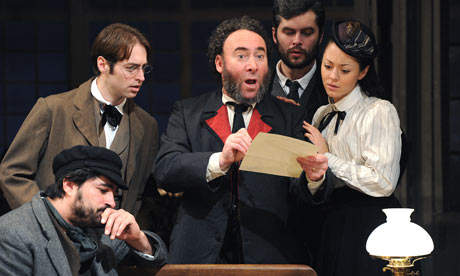
A Day in the Death of Joe Egg is Nottingham Playhouse’s latest offering and both contrasts and compliments nicely with their last in-house show, Forever Young. Peter Nichols’ play, about two parents and how they deal with living with their severely disabled daughter – the Joe of the title, deals with a serious and contemporary subject but with a lot of humour.
Bri and Sheila are two parents raising their 11 year old daughter Jo, whom is restricted to a wheelchair and unable to communicate due to severe cerebal palsy. Bri, a school teacher, finds making jokes and creating personalities and identities for Jo helps him cope whilst for Sheila this becomes constricting and she leaves for her amateur dramatics rehearsal with Bri in charge of Jo. The first half sets this context and then tells the story of Jo’s early life through speeches and multi-roled flashbacks with Bri of them taking on the other characters. The second half sees Sheila return from rehearsal and the arrival of Bri’s mother. Shiela is accompanied by Freddie, an old school contemporary of Bri’s, and his wife, Pam. They appear embody the petty bourgeois with Freddie extolling socialist virtue whilst Pam talks about her dislike of ‘weirdies’, what she terms Jo. Bri brings Jo down to meet Pam and Freddie then she takes a turn for the worse which begins a succession of events with Pam having to go to the chemists to get Jo’s medicine, Freddie calling for an ambulance at the pay phone and finally Bri leaving Jo in the back of his freezing car in an act of euthanasia. We then skip to the next morning and Bri is leaving Sheila before she and Jo get back from the hospital, he says he can’t cope with the constriction of Jo, suddenly Jo and Sheila get back. However, when she goes into the kitchen to fix them some breakfast he leaves.
Matt Aston’s direction picks out the inherent comedy in the piece and the show is still a period piece with the creative team retaining the late 1960s setting and thus, possibly, being able to use the language with a bit more freedom. Mark Benton’s Bri is a natural comedian but his performance was rushed and he hurried through moments that would have raised the pathos. Tim Dantay and Sarah White as Freddie and Pam give good turns but the real star of the show is Amy Robbins who, as Bri’s long suffering and acused wife Sheila, gives a performance full of emotion and experience. The design of Bri and Sheila’s home was beautiful with the ceiling resembling the inner cortex of the eye echoing the metaphor of sight which runs through the second half. However the light-up, musical style stairs which protrude into the audience from the proscenium did not convince neither did the actress playing Jo coming skipping on to announce the interval. This was a preview and the show did have some great moments with others which could sparkle further into the run but Mark Benton’s rushed performance, especially considering the amount Bri reveals to the audience in his long speeches, didn’t make the show feel as assured as it otherwise would have been.
A Day in the Death of Joe Egg: ***
Image courtesy of Robert Day.



